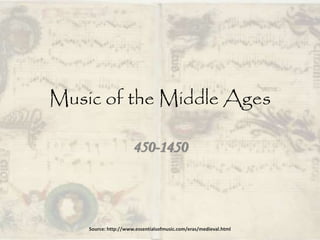
Music Of The Middle Ages
- 1. Music of the Middle Ages 450-1450 Source: http://www.essentialsofmusic.com/eras/medieval.html
- 2. Medieval Music 450-1450 Historical Themes • The spread of Christianity • The development of a European culture • The influence of Islamic culture Musical Context • The music of the church • The beginning of musical notation • The birth of polyphony • The rise of courtly culture Style • For such a vast period of time, there is a remarkable continuity in musical styles in the Middle Ages. In order to understand them better, it is a good idea to group their distinctive features within the broad categories of monophonic and polyphonic styles. – Monophonic Style – Polyphonic Style Composers
- 4. The Spread of Christianity • The Christian religion began as an underground sect of messianic Judaism in the first century C.E. Its practitioners were first persecuted, then tolerated; finally Christianity was accepted as the official religion of the Roman Empire. After the fall of the Western Empire, it emerged as the central unifying force in medieval Europe.
- 5. The development of a European culture • After the fall of the Roman Empire in the fifth century, the former Roman lands were ruled by various barbarian lords. These lands were eventually united by the Frankish kings, culminating in the crowning of Charlemagne (742-814) as Holy Roman Emperor.
- 6. The influence of Islamic culture • As the followers of the prophet Mohammed (570?-632) expanded their territory through the Middle East and the Mediterranean, they preserved and built on the knowledge of the ancient Greeks and Romans. • Through conflict (the Crusades) and coexistence (the multicultural Iberian Peninsula), Europe gained much from its contacts with this rich culture.
- 8. The Music of the Church • Music was an integral part of Christian worship. The daily liturgy provided innumerable texts, all set to music in the style we call Gregorian chant. • The church served as an important patron of the arts, specifically of music . • Throughout the period, the majority of composers were associated with and supported by the church.
- 9. The Beginning of Musical Notation • As in many non-Western cultures, music in early medieval Europe did not have a system of notation. It was not until perhaps the ninth century that a basic system of notation was developed. • Notating music was a difficult and time-consuming process. It was only in the cathedrals and monasteries that such work could be done on a regular basis. • Therefore, nearly all the music preserved (until the twelfth century) was written for the church. • The advent of notation also produced a markedly stable body of music, one of the features of Western musical culture.
- 10. The Birth of Polyphony • Descriptions of polyphonic singing date back to the ninth century, but the practice actually began earlier in improvised performances. • Polyphony is a distinctive feature of Western music. Its development became the primary focus for composers from the thirteenth century on. • Complex polyphony demanded specialized training for composers. • The composition of plainchant was primarily an activity of the monastery and convent, but by the fourteenth century, composers were more often members of the university- trained elite of the church. • This change explains, in part, the lack of female composers of polyphony.
- 11. The Rise of Courtly Culture • The nobility of southern France created an elaborate society centered on the court, a practice that spread throughout the whole of Europe. • Music was an important activity of these courts, and the aristocracy took part in the performance and composition of secular works. Surviving examples are found in music of the troubadours and trouvères, beginning in the twelfth century. • By the fourteenth century, the polyphonic style took hold in secular music. • Secular polyphony was produced by highly trained specialists in the art of music rather than by the aristocracy.
- 12. MUSICAL STYLE
- 13. Monophonic Style • A simple monophonic texture might be enriched by the use of drones and (in secular music) percussion. • Rhythm was often not notated. We assume that it was tied to text in vocal music and to dance in instrumental music. • Melodies are often long and flowing. Texted music is often melismatic. • Form comes from text in vocal music. The structure of instrumental music is based on repeating sections.
- 14. Polyphonic Style • Voices and instruments were often mixed. • Nonimitative counterpoint, with voices moving at different rhythmic speeds, is the primary texture. • Rhythms are often restless and active. • Melodies are long and asymmetrical. • Harmony is based on open fifths and octaves. • Dissonances are often sharp and unexpected. • Pieces are often built on a cantus firmus, and the structure is formed from repetitions of that melody.
- 15. COMPOSERS
- 16. • Anonymous • Hildegard von Bingen (1098-1179) • Moniot d'Arras (fl.1213-1239) • Guillaume de Machaut (c.1300-1377)
